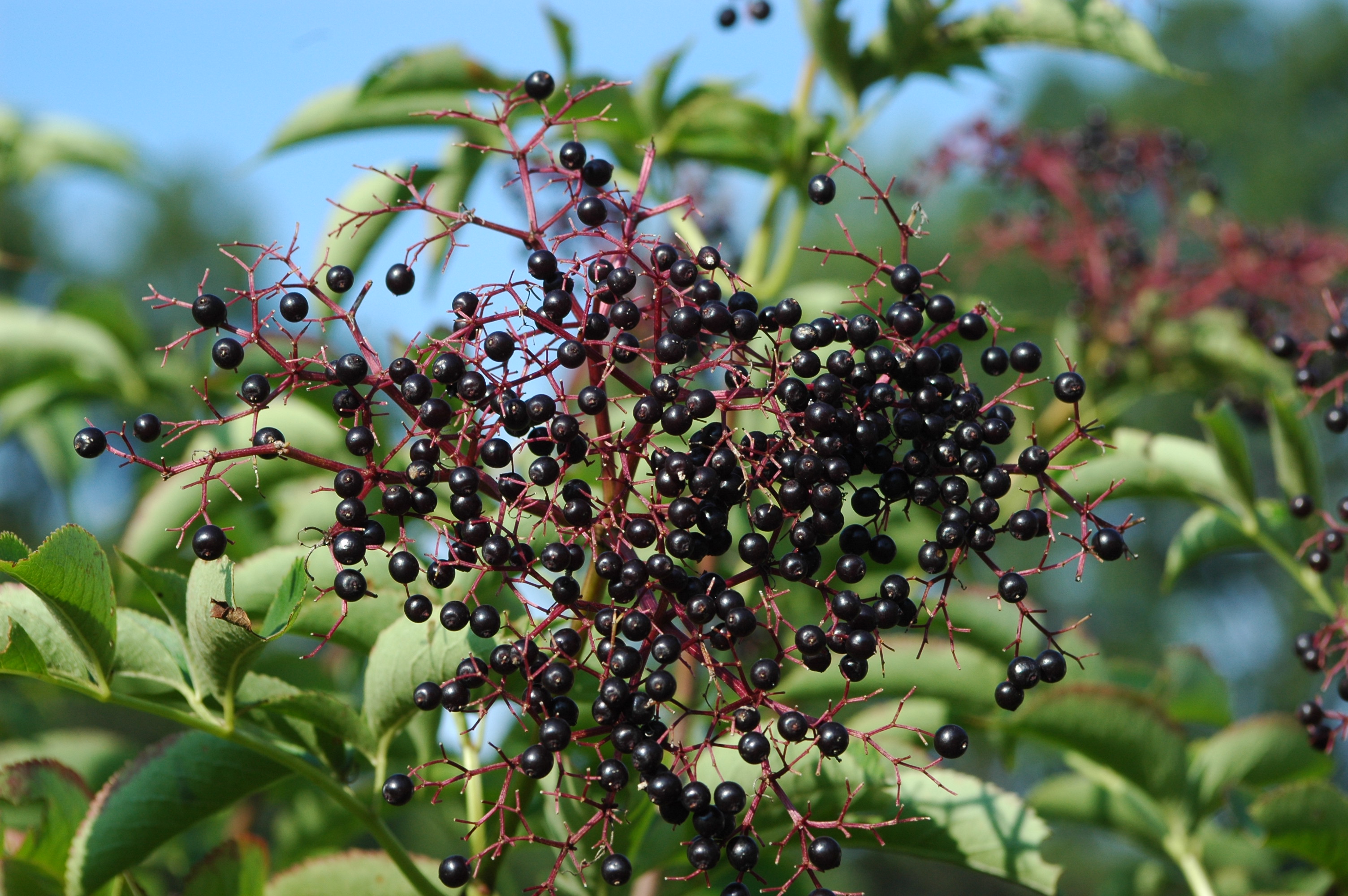
Common Name: Canadian Elderberry | Scientific Name: Sambucus nigra

Family Name: Caprifoliaceae
Introduction
Its funny how life works. I was at my farm in DC and was noticing how well my elderberry bushes were doing. They were in full bloom and promised a huge crop of berries. The next day I flew to England to catch up with some herbal medical school friends, and there too the elderberries were white with flowers. My side kick Vince and I were walking the Yorkshire dales in search of a stone circle and we saw countless elderberry bushes in bloom. When we got back to town, in this case, Scarborough, we went to the cafe, and were served the most delicious elder flower soft drink. It is a beverage you don’t come across much in America and honestly I forgot how tasty it is. Vince was hugely impressed with this beverage and was even more surprised to discover that the drink made from the flowers is not only a fantastic mouth experience, but, a powerful medicine.
And, that is probably the best way to introduce Elderberry. Powerful medicine. And more specifically, a powerful healing stimulant. Just about the whole plant can be used to fire up the body to heal itself. The the bark can be used to heal wounds, and the flowers and berries can be used to fight all kinds of infections. Indeed, hot elder flower or elderberry tea, taken at the first sign of a cold, will stop a cold from happening or shorten its duration and severity. If you want to stimulate your body to heal itself, think about elderflowers or elderberries.
The best part is that you can find elderberry syrup at just about any CVS and the elderberry soft drink can be found at Whole Foods! So, this super hot remedy is not hard to find!
It was one of the plants I studied in my PhD research and my conclusion was simple. Various parts of the plant stimulated the body to renewed action and healing. Whatever health is, this fantastic food seems to give it a kick in the rear end!
Below you will find the article from my thesis. If that has not bored you to tears, you will also find what the Eclectic Physicians had to say about elder. The Eclectics were 19th century American doctors that specialized in getting the body to heal itself. Read on if you dare!
Resources
Chapter from My PhD Thesis
Notes from the Eclectic Physicians
Chapter from My PhD Thesis
Common Name: Elder Flower
Common Name: Elder Berry
Scientific Name: Sambucus nigra
Scientific Name: Sambucus canadensis
Part Used: Fresh inner bark. Also flowers, bark, berries.
Chemical Constituents: Significant phytochemicals include campesterol, morroniside, and stigmasterol. (9)
History
Sambucus canadensis is found near streams and ponds throughout much of North America . Native Americans used both as a food and medicine. Records indicate that the Illinois-Miami, Onondaga, Iroquois, Seneca, Menomini, Potawatami, Malecite, and MicMac tribes used the drug. Native Americans saw the drug as being diuretic, febrifuge, expectorant, laxative, and a convalescent aid. It was thought to be useful in rheumatic complaints, malaria, fevers, diabetes, and congestion. The Colonials, familiar with its European cousin, Sambucus nigra, used the drug to treat syphilis, gout, and sore legs. The flowers were mixed with lard to prepare an ointment for burns, scalds, wounds, and obstinate sores. The berries were used to treat habitual constipation, rheumatism, gout, and skin disease. Though mostly used as a domestic medicine, physicians used the drug. (10)
Eclectic Physicians Uses (1–8)
Actions
Diaphoretic, gentle stimulant, diuretic, alterative, cooling, aperient, purgative, deobstruent, resolvent, promotes all fluid secretions, discutient, stimulant to all excretory organs increasing secretion, increases waste removal in syphilis, scrofula, and other diseases attended by deposits or depravation of tissues, useful in conditions with fullness of tissues from an increased amount of fluid, improves the nutritive fluids, improves appetite and digestion.
Indications
“In skin affections, when the tissues are full, flabby, and oedematous; epidermis separates and discharge of serum is abundant, forming crusts; indolent ulcers, with soft, oedematous borders; mucous patches, with free secretions; post-scarlatinal dropsy; low deposits in, or depravation of tissues.” (6)
General
Erysipelatous disease, rheumatism, gout, eruptive disease, scrofulous, tuberculosis, systemic tuberculosis, syphilis, dropsy following scarlatina, febrile and exanthematous diseases, chronic diseases, impurities of the blood, cachectic states of the system, herpetic and all forms of chronic cutaneous eruptions, old ulcers, other depravities of the system, alterative where there is a tendency to unhealthy deposits in or depravation of tissues, urinary inactivity, with excretion of renal sand, accompanied with muscular aching, stiffness, or rheumatic pains.
Digestive
Hepatic derangements of children.
Respiratory
Catarrhal nasal obstructions.
Skin
Erysipelas, burns, scalds, abrasions of the surface, irritation and superficial inflammation, cutaneous diseases, topically for all eruptions that arise on full tissues and attended by abundant serous discharge, eczema infantinilis, milk scald, indolent ulcers, with soft oedematous borders, serous secretion, all forms of chronic cutaneous eruptions, scrofula, old ulcers, skin affections where the tissues are full and flabby and oedematous and the epidermis easily separates with abundant discharge of serum and crust formation.
The drug from Selye’s perspective
Resistance
The drug was used to raise resistance to infections including eruptive infections, tuberculosis, syphilis, malaria, influenza, and staphylococcus. It was used to raise resistance to autoimmune diseases like rheumatoid arthritis. It was used to raise resistance to disease attended with deposits and depravity of tissue including gout and post scarlatinal dropsy (nephritis).
Exhaustion
The drug was used when State of Exhaustion set in. Diseases causing the State of Exhaustion included those of microbial and autoimmune origin. The symptoms of State of Exhaustion included waste retention, cachectic states, herpetic skin eruptions, chronic skin eruptions, old ulcers, depravity of the system, unhealthy deposits in the skin, rheumatic bone pains, oedematous skin affections, skin when epidermis easily separates, and kidney failure. The hallmark of the drug was its use in State of Exhaustion when there was failure of the waste removal.
Adaptation Energy
From Selye’s perspective, the drug was used to augment the GAS, which suggests it increases adaptation energy. Evidence to this effect includes the following. It was used to raise resistance to infection and autoimmune disease. It was used when State of Exhaustion set in. It was used when vital energy ran low, and physiological function was thereby diminished. It was used especially when the processes of waste removal were depressed and toxins remained in the body. Lastly, it was used to inspire healing in old ulcers and wounds.
Brekhman’s Adaptogen Criterion
An adaptogen should be innocuous and cause minimal disorders in the physiological functions of an organism.
The drug is considered innocuous in both Eclectic and contemporary literature. (1–12)
The action of an adaptogen should be non-specific i.e. it should increase resistance to adverse influences of a wide range of factors of physical, chemical, and biological nature.
Clinically, the drug was used to increase resistance to bacterial and viral infection, both acute and chronic. It was used to raise resistance to hyper and autoimmune disease. (1–8)
Experimentally, the crude drug raises resistance to free radical damage and bacterial infection. (11, 12) The drug contains compounds that raise resistance to free radical damage, cancer, and liver damage. (9)
An adaptogen may possess normalising action irrespective of the direction of the foregoing pathological changes.
Clinically, the drug was used to normalise physiological abnormalities associated with State of Exhaustion . This included temperature abnormalities, tendency to ulceration, and membrane permeability abnormalities. The drug was used to normalise secretions that had become excessive or diminished (constipation, lack of urine production, absence or excessive sweating, excessive or inadequate mucous production, etc.). (1–8)
Experimentally, the drug contains compounds, which normalise anaemia, arthritis, inflammation, diabetes, water retention, ulceration, uraemia intoxication, poisoning, hypertension, and hyperglycaemia. (9)
Discussion
The drug exhibits properties consistent with Brekhman’s definition of an adaptogen. It is innocuous; it raises resistance to an assortment of biological threats, and normalises function.
Sambucus canadensis might be seen as the colonial medicine tree. It was common knowledge that the inner bark of the tree could be used to stimulate healing in a wound and that the berries could be used to speed recovery from influenza. When the Eclectic movement began, the general population knew Sambucus canadensis to be a vitality stimulant.
The Eclectics took this knowledge on board and refined it. They used the drug to raise resistance to the problematic infectious diseases of their day. It was used to raise resistance to epidemic scarlet fever and syphilis. It was also used when resistance failed, and State of Exhaustion set in. They noted that when constitutional collapse (State of Exhaustion ) was strongly manifest in the organs of waste removal, the drug was especially efficient. When the sweat glands and kidneys were unable to remove waste from circulation, and the waste ended up in the skin, joints, and bones, the drug was found to be highly serviceable.
Potential Clinical Applications
The Eclectics used this drug when State of Exhaustion resulted in debility of the systems of waste removal. There is experimental data supporting this use of the drug. The drug may have a role in raising resistance to waste retention in chronic disease.
Future Research
• Sambucus canadensis (green inner bark, flowers, berries) and its effects of on GAS. The various parts of the drug should be tested out in the animal model to determine their specific effects on the GAS.
• Sambucus canadensis and its effect in chronic waste retention. Clinically, the drug was used when the body was no longer able to remove waste from circulation. Its role in increasing resistance to conditions like gout and kidney failure should be examined.
• Sambucus canadensis and wound healing. Clinically, the drug was used to inspire healing in slow healing wounds. Its role in wound management should be explored.
Eco-availability
The drug is common in the wild and readily grown.
References
• King, John. The American Eclectic Dispensatory. Moore , Wilstach, and Keys. Cincinnati . 1854. P. 841.
• Scudder, J. M. Specific Medication and Specific Medicines. Revised. Fifth Edition. Wilstach, Baldwin and Company. Cincinnati . 1874. P. 234.
• Scudder, J. M. The American Eclectic Materia Medica and Therapeutics. Published by the Author. Cincinnati . 1883. P. 253.
• Scudder, J. M. The Eclectic Family Physician. Twenty first edition, fifth revision. Two volumes in one, with appendix. John K. Scudder. Cincinnati . 1887. P. 224.
• Felter, Harvey Wickes and Lloyd, John Uri. Kings’ American Dispensatory. Volume one and Volume two. Ohio Valley Company. Cincinnati . 1898. P. 1706.
• Ellingwood, Finley. A Systematic Treatise on Materia Medica and Therapeutics with reference to the most direct action of drugs. Fifth Edition thoroughly revised and greatly enlarged. Chicago Medical Times Publishing Company. 1905.
• Fyfe, John William. Pocket Essentials of Modern Materia Medica and Therapeutics. The Scudder Brothers Company. 1903. P. 261.
• Ellingwood, Finley. American Materia Medica, Therapeutics, and Pharmacognosy. Ellingwood’s Therapeutist. Chicago . 1919. P. 451.
• Dr. Dukes Phytochemical and Ethnobotanical Databases. Agriculture Research Service. USDA.
• Erichson-Brown, Charlotte . Medicinal and other uses of Native American Plants. Dover Press. New York . 1979. P. 122–35.
• Seeram et al. Cyclo-oxygenase inhibitory and anti-oxidant cyanidin glycosides in cherries and berries. Phytomedicine 2001 Sept; 8(5): 362–9. From PubMed abstracts.
• Holetz et al. Screening some plants used in Brazilian folk medicine for the treatment of infectious disease. Mem.Inst.Oswaldo Cruz.2002 Oct; 97(7): 1027. From PubMed abstracts.
Notes from the Eclectic Physicians
1854; King J; (Materia Medica) – SAMBUCUS CANADENSIS
Properties and Uses. – In warm infusion the flowers are diaphoretic, and gently stimulant; in cold infusion they are diuretic, alterative, and cooling, and may be used in all diseases requiring such action, as in hepatic derangements of children, erysipelas, erysipelatous diseases, etc. In infusion with maidenhair and beech-drops, they will be found very valuable in all erysipelatous diseases. The expressed juice of the berries , evaporated to the consistence of a syrup, is a valuable aperient and alterative; one ounce of it will purge. An infusion of the young leaf-buds are likewise purgative, and sometimes act with violence. The flowers and expressed juice of the berries have been beneficially employed in rheumatic, gouty, eruptive, scrofulous, and syphilitic diseases. The inner green bark is cathartic; an infusion of it in wine, or the expressed juice will purge moderately, in doses of from half a fluidounce to a fluidounce; large doses produce emesis; in smaller ones it proves an efficacious deobstruent, promoting all the fluid secretions, and is much used in dropsy, especially that following scarlatina, and other febrile and exanthematous diseases, as well as in many chronic diseases. Beaten up with lard or cream, it forms an excellent discutient ointment, and which is of much value in burns, scalds, and some cutaneous diseases. The juice of the root in ounce doses, daily, acts as a hydragogue cathartic and diuretic, and will be found valuable in all dropsical affections.
1873: Scudder
Prepare a tincture from the fresh inner bark of the elder, 35viij.to alcohol50%Oj.Dose gtts.ij.to gtts.x.
The elder is a stimulant to all the excretory organs increasing secretion. It may be employed for the general purposes of an laterative, increasing waste, in syphilis,scrofula, and other diseases attended by deposits or depravation of tissues. It is especially useful in these cases where there is an edematous condition, or fullness of tissue from an increaseed amount of water. We meet a case of chronic disease occasioanlly, in which the tissues are full and flabby, ecidently from too much water; in thse samubucus is a good remedy. It may be employed in dropsy, though its action is not so decided as the apocynum.
As a local application the sambucus is specific to those erupotans that arise on full tissues(as above), and are attended with abundant serous discharge. Thus in some forms of eczema infatinilis or milk scall, and in the above for of the disease, it will aone effect a cure. We also employ it in indolent ulcers, with soft edmatous borders, and serou secretion, and in mucous patches with free secretion. An ointment is prepared by simmering the inner bark in gresh butter, old style, or a glycerole may be made, with the addition of the usual quantity of starch.
1883: Scudder: (diuretic)
The young roots of the common elder possess diuretic properties. A decoction made of the roots and drank freely, will be found beneficial in dropsical affections; it may be associated with juniper berries, horseradish, cream of tartar, etc., with much advantage. The inner bark of the elder forms an efficient hydragogue cathartic and diuretic; it may be employed tinctured in wine or cider. It is taken to the extent of keeping the bowels loose.
1883: Scudder: (alterative)
(The flowers, berries and inner bark of Sambucus Canadensis)
Preparation – An infusion. Tincture of Sambucus (the inner bark and root).
Dose – Of the tincture, from five drops to one drachm.
Therapeutic Action – The Elder is described as alterative, laxative, diuretic, diaphoretic, emetic, hydragogue, cathartic, and resolvent.
The flowers are esteemed valuable in all impurities of the blood, or cachectic states of the system, as in herpetic and all forms or chronic cutaneous eruptions, scrofula, old ulcers, and other depraves states of the system. Though feeble in action yet they are highly sanative, and serve to improve the nutritive fluids and promote healthy secretions. They are mildly diaphoretic, devoid very nearly of excitant qualities, and are deemed useful in the diseases of children when of a mild character, in obviating costiveness, and in lessening febrile excitement, and promoting diaphoresis and diuresis.
The inner bark is used as a hydragogue cathartic and diuretic in dropsy, and as an alterative in chronic diseases; if taken in large doses it causes emesis. It is said to have cured many cases of dropsy that had resisted other agents of reputed efficacy. It is prepared by boiling one ounce of the bark in two pints of water to one, of which the dose is from two to four ounces, repeated often; in smaller doses it acts as an aperient and resolvent; or it may be used in the form of a vinous infusion.
An ointment, prepared by simmering the inner bark is fresh butter, cream or lard, and adding a small portion of beeswax to harden it, is an excellent application in cases of burns, abrasions of the surface, eruptions, irritation and superfacial inflammation; and when prepared in the same manner, with the addition of white-oak bark, it is an efficacious application to abraded parts, occasioned by long confinement to bed.
1887: Scudder: SAMBUCUS CANADENSIS: ELDER
An infusion of the flowers of the common elder forms a very pleasant and effectual alterative for children, in scrofulous or skin diseases. They are slightly diaphoretic and laxative, and improve the appetite and digestion. The bark may be employed for the same purpose in the adult, but must be used with care, as it is a cathartic. The bark of the root is a powerful diuretic, and may be used in dropsy.
1898: Felter and Lloyd – SAMBUCUS (U.S.P.) – SAMBUCUS
Action, Medical Uses,and Dosage – Sambucus is stimulant to all of the emunctories, increasing secretion. In warm infusion, elder flowers are diaphoretic and gently stimulant; in cold infusion, they are diuretic, alterative, and cooling, and may be used in all diseases requiring such action, as in hepatic derangements of children, erysipelas, erysipelatous diseases, etc. In infusion, with maidenhair and beech-drops, they will be found very valuable in all erysipelatous diseases. The expressed juice of the berries, evaporated to the consistence of a syrup, is a valuable aperient and alterative; 1 ounce of it will purge. An infusion of the young leaf-buds is likewise purgative, and sometimes acts with violence. The flowers and expressed juice of the berries have been beneficially employed in scrofula, cutaneous diseases, syphilis, rheumatism, etc. The inner green bark is cathartic; an infusion of it in wine or cider, or the expressed juice, will purge moderately, in doses of from 1/2 to 1 fluid ounce; large doses produce emesis; in small ones, it proves an efficient deobstruent, promoting all the fluid secretions, and is much used in dropsy, especially that following scarlatina, and other febrile and exanthematous diseases, as well as in many chronic diseases. Specific sambucus is largely used as an alterative where there is a tendency to unhealthy deposits in, or depravation of the tissues. The chief indication for sambucus is a fullness or oedematous condition of the parts, giving them a watery and flabby appearance. In these conditions it is a valuable agent in dropsy. Webster asserts that small doses of specific sambucus are valuable in the catarrhal nasal obstructions of infants. The juice of the root in 1/2 ounce doses, daily, acts as a hydragogue cathartic and diuretic, and will be found valuable in dropsical affections requiring purgation.
Externally, sambucus is a valuable agent, especially for eruptions which appear upon the full, flabby, oedematous tissues as described above, and particularly when attended with abundant discharge of serum. Beaten up with lard or cream, it forms an excellent discutient ointment, which is of much value in burns, scalds, and some cutaneous diseases, such as eczema, wmil…..ll, old ulcers, with soft, oedematous edges and free secretion of serum, and in mucous patches, with free discharges. The dose of specific sambucus ranges from 1 to 60 drops; decoction (inner bark, 2 ounces, to water, 1 quart, boiled down to 1 pint), from 2 to 4 fluid ounces.
Specific Indications and Uses – In skin affections, when the tissues are full, flabby, and oedematous; epidermis separates and discharge of serum is abundant, forming crusts; indolent ulcers, with soft, oedematous borders; mucous patches, with free secretions; post-scarlatinal dropsy; low deposits in, or depravation of tissues.
1901: Locke
Sambucus is a stimulant; the flowers in warm infusion diaphoretic and stimulant; cold infusion diuretic and alterative. This agent is chiefly valued for its green inner bark, form which specific sambucus is prepared. This is largely employed in skin affections where the tissues are full and flabby and oedematous. THe epidermis easily seperates and an abundant discharge of serum takes place, forming crusts. It is also useful in indolent ulcers, with soft edematous borders, anf for mucous patches, with abundant secretion. Low deposits with depravation of tissue and watery infiltration, is the key note to its use. it is serviceable in dropsy, particult the post scarlatinal form,l and is useful in the catarhal nasal obstructions of infants. The dose of specific sambucus is from 1-60 drops, of the tincture, one ounce to one quart of water boled down to one pint, two to four fluid ounces.
1906: Ellingwood
The strong infusion is diaphoretic and stimulating. The agent has also alterative, cathartic and diuretic properties which are of value in urinary inactivity, with excretion of renal sand, accompanied with muscular aching, stiffness, or rheumatic pains. A strong infusion is sometimes of great service in removing dropsical effusions. Cases are reported in which extreme general dropsy seemed to threaten immediate death, where relief was quickly and permanently obtained by the use of this remedy.
1911: Fyfe
Hepatic diseases, especially of children; dropsies of all kinds, and especially those following scarlet fever and other febrile exanthematous diseases’oedema of the tissues, with evident excess of water in the part, eczematous eruptions with abundant discharge from the eruptian; ulceration with free serous secretion, nocturnal asthma, coming on suddenly, the perspiration being supressed during sleep, and returning as the paroxysm subsides.
This agent increases the functional activity of excretory glands, especially of the skin and mucous surfaces, and causes profuse diuresis. It should be taken to the extent of keeping the bowels loose.
Sambucus canadensis is diuretic, alterative, deobstruant and purgative. In very large doses it is emetic.
1919: Ellingwood – SAMBUCUS, SAMBUCUS CANADENSIS
Synonym – Elder.
Preparations – Specific Sambucus. Dose, from two to ten drops.
Therapy – The strong infusion is diaphoretic and stimulating. The agent has also alterative, cathartic and diuretic properties which are of value in urinary inactivity, with excretion of renal sand, accompanied with muscular aching, stiffness, or rheumatic pains.
A strong infusion is sometimes of great service in removing dropsical effusions. Cases are reported in which extreme general dropsy seemed to threaten immediate death, where relief was quickly and permanently obtained by the use of this remedy.
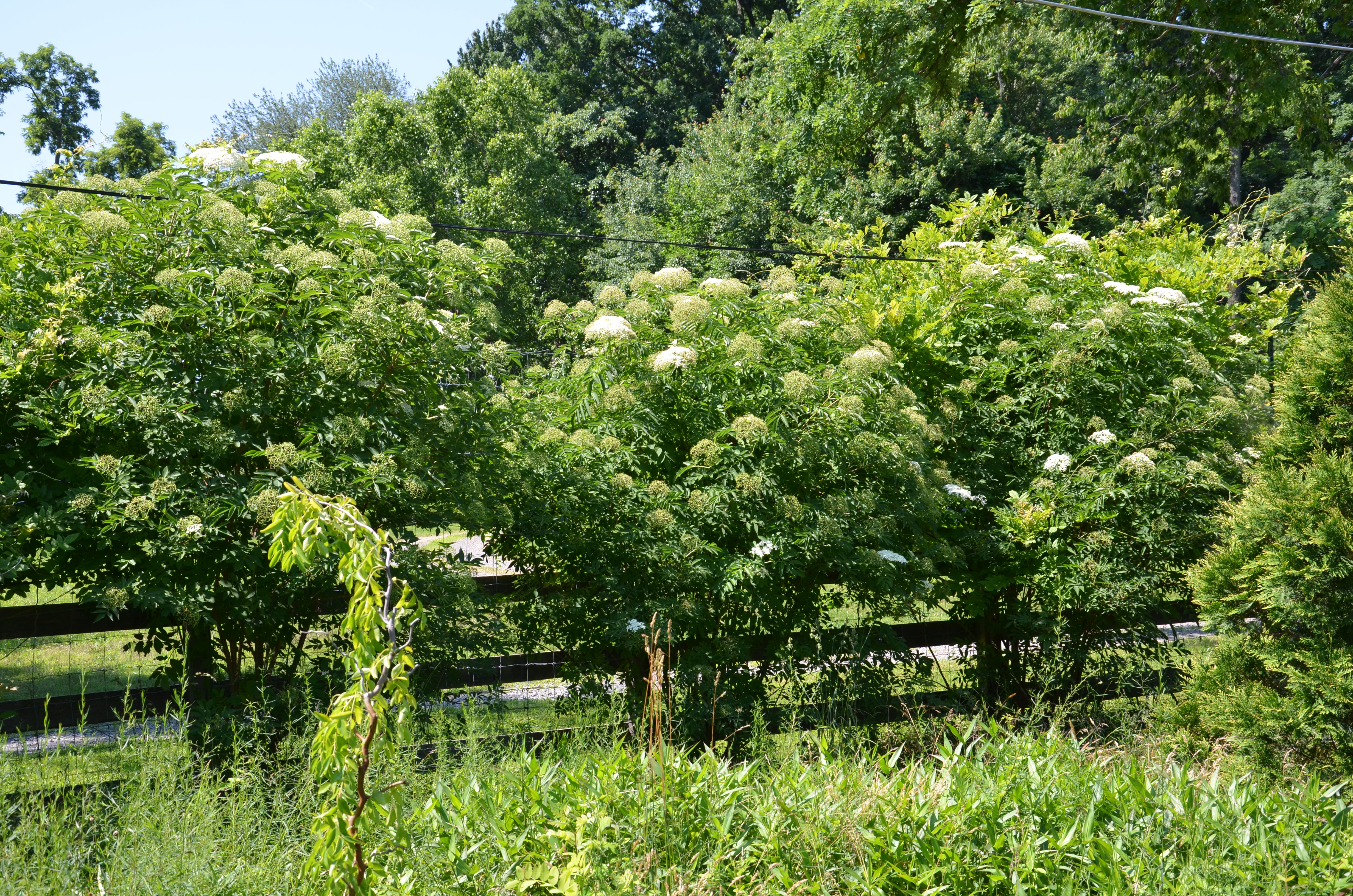 In North America, the elderberry can be found growing from coast to coast, usually near water or a moist location. The birds love the berries and they deposit the bushes all over the place. These are elderberries that came up on my property all on their own. They are an ideal source of health... you dont have to grow them, they grown themselves. Indeed, the birds will even plant them for you!
In North America, the elderberry can be found growing from coast to coast, usually near water or a moist location. The birds love the berries and they deposit the bushes all over the place. These are elderberries that came up on my property all on their own. They are an ideal source of health... you dont have to grow them, they grown themselves. Indeed, the birds will even plant them for you!
 The Elderberry bush provides two useful items, flowers and fruit. The Flowers can be used to make one of the tastiest beverages around, elderberry presse. The flowers are infused with a little lemon peel, in hot water, sweetened and then chilled. Its a really delicious taste and it has the added benefit of stimulating the immune system. Served hot, historically it has been one of the most popular European cold busters.
The Elderberry bush provides two useful items, flowers and fruit. The Flowers can be used to make one of the tastiest beverages around, elderberry presse. The flowers are infused with a little lemon peel, in hot water, sweetened and then chilled. Its a really delicious taste and it has the added benefit of stimulating the immune system. Served hot, historically it has been one of the most popular European cold busters.
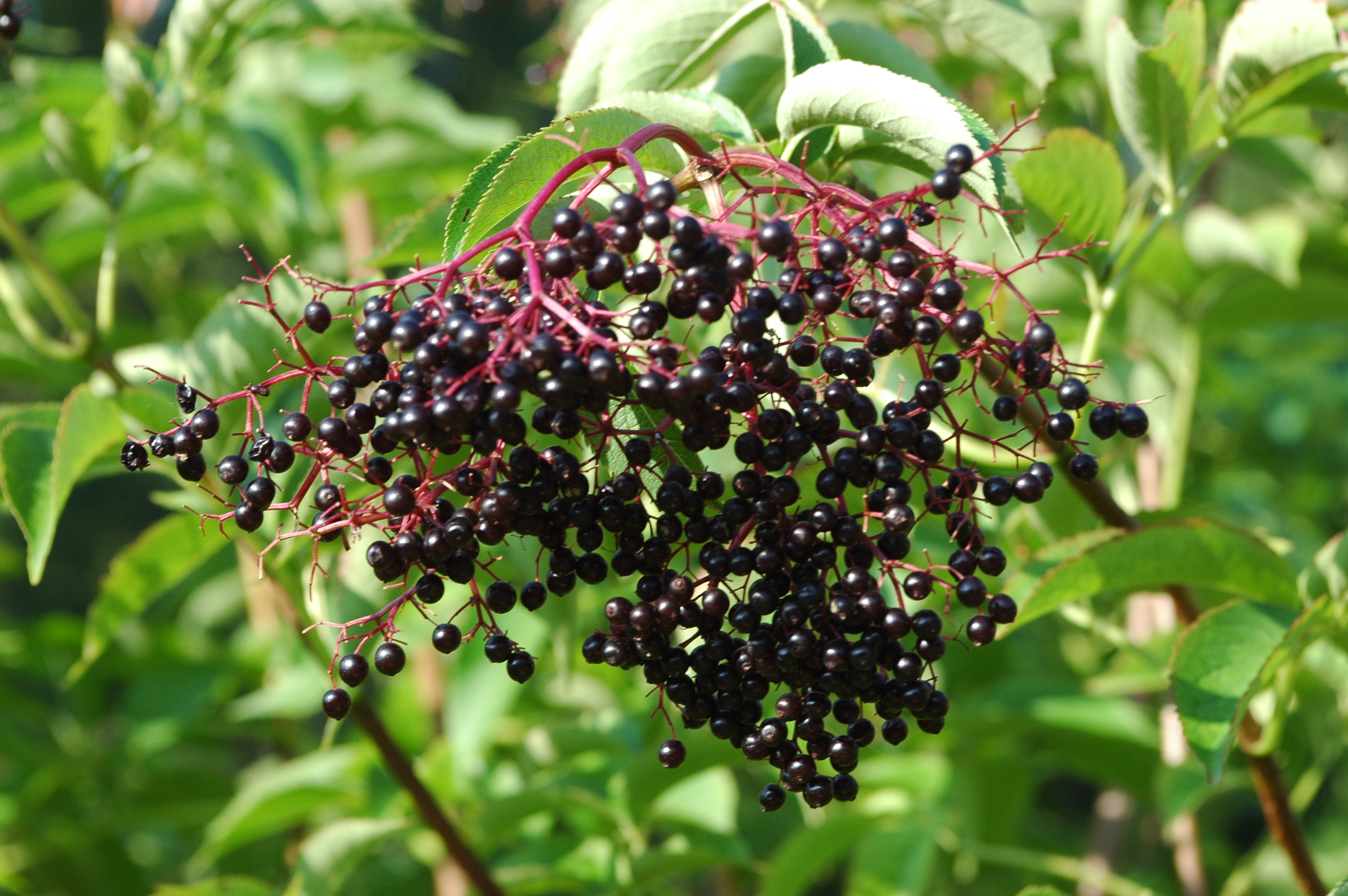 The bush also produces tons of berries. Now, this is a question mark situation. My grandmother used to rant and rave about the delicious elderberry cobbler my great grandmother made. Well, I made it and was I sorry. The berries had this peculiar metalic taste that was nauseating. Apparently somepeople like it, not me, I think the berries have a nasty flavor.
The bush also produces tons of berries. Now, this is a question mark situation. My grandmother used to rant and rave about the delicious elderberry cobbler my great grandmother made. Well, I made it and was I sorry. The berries had this peculiar metalic taste that was nauseating. Apparently somepeople like it, not me, I think the berries have a nasty flavor.
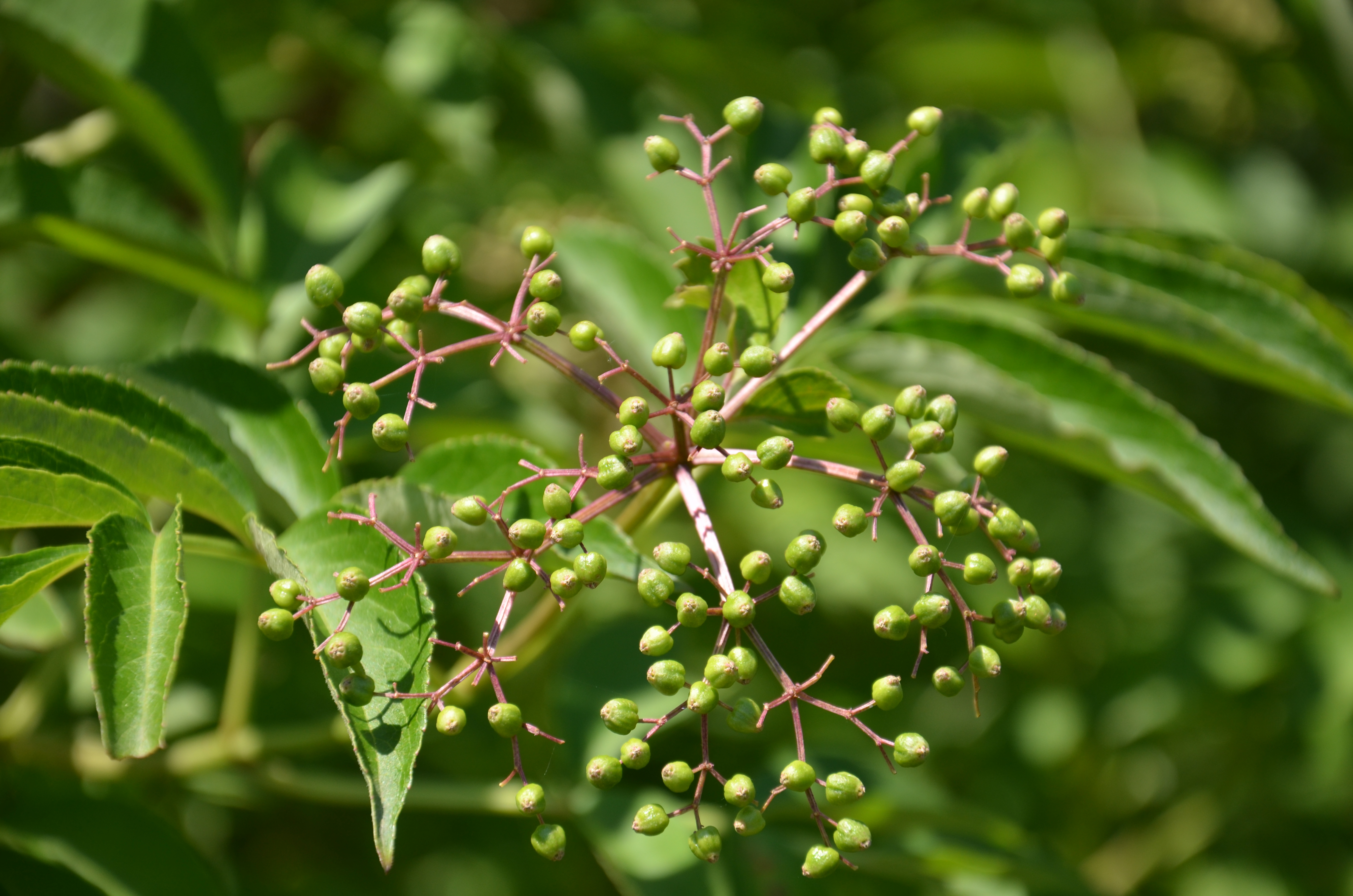 Though I would never think about eating elderberries for fun, it appears they are extremely effective when it comes to treating colds and even influenza. We have not had a flu pandemic in a long time and its only a matter of time. I made ten gallons of elderberry syrup and keep it in the pantry in the event the flu spreads around the globe.... and to prevent it from spreading to my farm. And, as a syrup to prevent or treat flu, with a nice amount of ginger to cover its natural flavor, its more than passable as a medicine. Oh, and by the way, only use purple ripe fruit. Apparently the green ones are poisonous.
Though I would never think about eating elderberries for fun, it appears they are extremely effective when it comes to treating colds and even influenza. We have not had a flu pandemic in a long time and its only a matter of time. I made ten gallons of elderberry syrup and keep it in the pantry in the event the flu spreads around the globe.... and to prevent it from spreading to my farm. And, as a syrup to prevent or treat flu, with a nice amount of ginger to cover its natural flavor, its more than passable as a medicine. Oh, and by the way, only use purple ripe fruit. Apparently the green ones are poisonous.
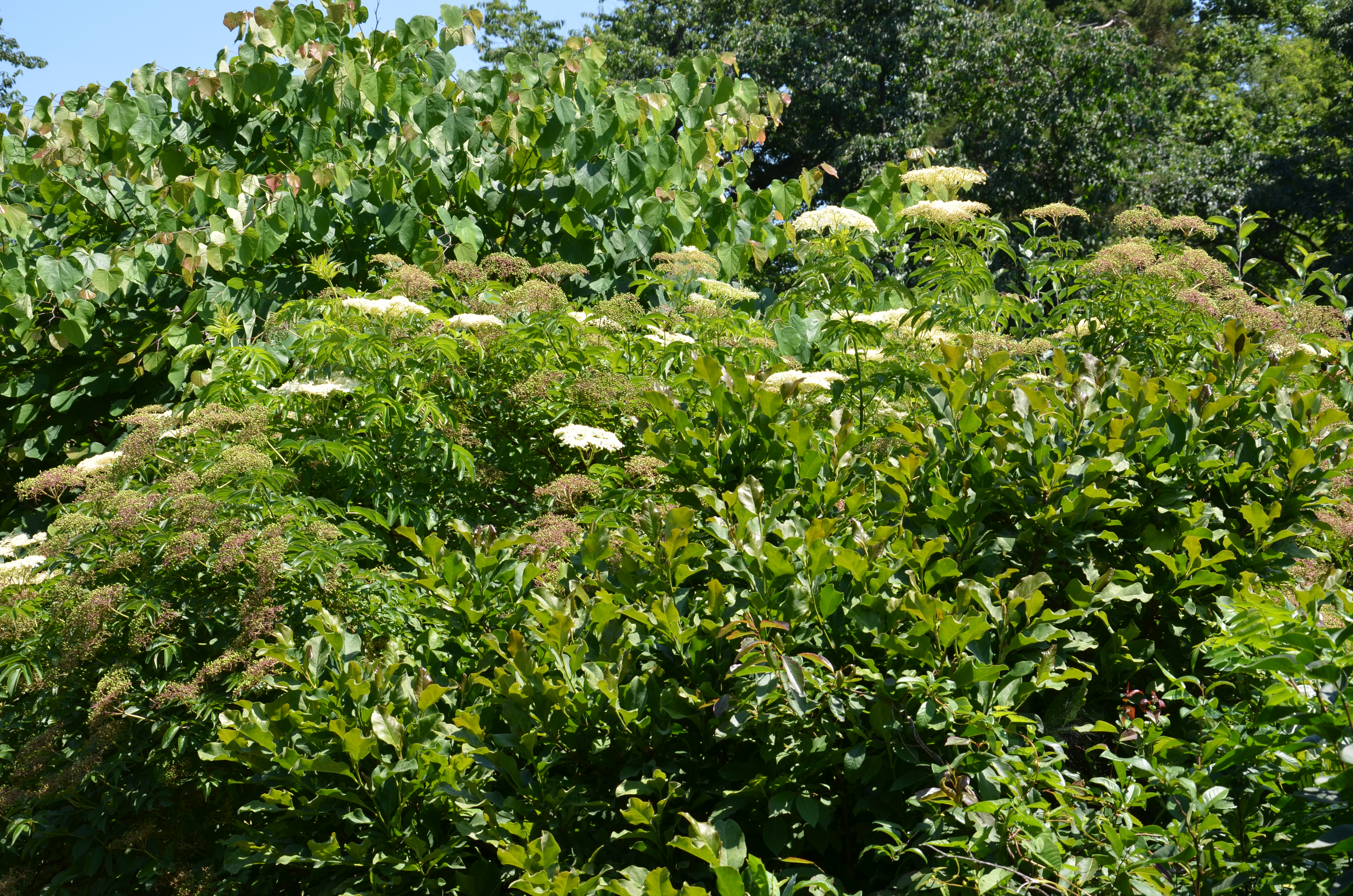 They key feature here is that elderberry grows itself and it has a culinary and a medicinal use. You do nothing and you end up with a source of delicious beverages and a anti-flu remedy. Win, win. And, you dont have to break a sweat to have these two products!
Getting one? Well, if the birds dont deliver one, you can order one. I have tried all the varieties and as far as Im concerned, the berries all taste like crap. So, I dont think it really matters which one you order. Just order one or two, stick them in, and let them do their thing.
They key feature here is that elderberry grows itself and it has a culinary and a medicinal use. You do nothing and you end up with a source of delicious beverages and a anti-flu remedy. Win, win. And, you dont have to break a sweat to have these two products!
Getting one? Well, if the birds dont deliver one, you can order one. I have tried all the varieties and as far as Im concerned, the berries all taste like crap. So, I dont think it really matters which one you order. Just order one or two, stick them in, and let them do their thing.
Disclaimer: The author makes no guarantees as to the the curative effect of any herb or tonic on this website, and no visitor should attempt to use any of the information herein provided as treatment for any illness, weakness, or disease without first consulting a physician or health care provider. Pregnant women should always consult first with a health care professional before taking any treatment.
